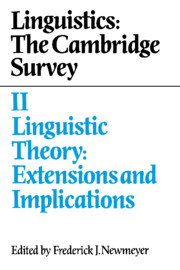Book contents
- Frontmatter
- Contents
- Contributors
- Preface
- 1 Extensions and implications of linguistic theory: an overview
- 2 Grammar and language processing
- 3 Grammatical principles of first language acquisition: theory and evidence
- 4 Second language acquisition and grammatical theory
- 5 Brain structures and linguistic capacity
- 6 Abnormal language acquisition and the modularity of language
- 7 Grammatical aspects of speech errors
- 8 Grammar and conversational principles
- 9 Discourse analysis: a part of the study of linguistic competence
- 10 Speech act distinctions in grammar
- 11 Computer applications of linguistic theory
- 12 Metrics and phonological theory
- 13 Grammatical theory and signed languages
- 14 The linguistic status of creole languages: two perspectives
- 14.I Creole languages and the bioprogram
- 14.II Are creoles a special type of language?
- 14.III A dialog concerning the linguistic status of creole languages
- Subject index
- Name index
- Contents of volumes I, III, and IV
10 - Speech act distinctions in grammar
Published online by Cambridge University Press: 08 February 2010
- Frontmatter
- Contents
- Contributors
- Preface
- 1 Extensions and implications of linguistic theory: an overview
- 2 Grammar and language processing
- 3 Grammatical principles of first language acquisition: theory and evidence
- 4 Second language acquisition and grammatical theory
- 5 Brain structures and linguistic capacity
- 6 Abnormal language acquisition and the modularity of language
- 7 Grammatical aspects of speech errors
- 8 Grammar and conversational principles
- 9 Discourse analysis: a part of the study of linguistic competence
- 10 Speech act distinctions in grammar
- 11 Computer applications of linguistic theory
- 12 Metrics and phonological theory
- 13 Grammatical theory and signed languages
- 14 The linguistic status of creole languages: two perspectives
- 14.I Creole languages and the bioprogram
- 14.II Are creoles a special type of language?
- 14.III A dialog concerning the linguistic status of creole languages
- Subject index
- Name index
- Contents of volumes I, III, and IV
Summary
Meaning, form, and function
In using natural language, a speaker may accomplish such things as warning, surprising, insulting, going on record, inquiring, commanding, conjecturing, and so on through a vast repertoire of effects that language is uniquely suited to achieving. Some of these effects are intended, some unwitting; some are more or less automatically associated with certain utterance types, and others are very loosely connected with the form or the content of the uttered token. In this chapter we will consider the extent to which acts of speaking are tied to the grammatical structure of an individual language, or language in general, and examine various views as to the nature of this connection, their benefits and drawbacks.
Locutions, illocutions, and perlocutions
In a work of great influence, the philosopher John Austin (1962) distinguished among three types of act that are ordinarily performed by someone who produces an utterance: locutionary, perlocutionary, and illocutionary acts. Locutionary acts are, according to Austin, those acts that form the substance of speech – they are acts of making use of the grammar of the language, its phonology, syntax, and semantics. Perlocutionary acts are the by-products (hence per-) of speaking certain words in a particular context. Typically, the affected party is the person spoken to, who may be embarrassed, confused, or convinced by what has been said. Though it is usual to treat the aforementioned effects as exhausting the range of perlocutions (as in Davis 1976), for completeness we must also include among perlocutions those by-product effects of speech that are not visited upon the addressee, e.g. embarrassing oneself, or divulging a secret to an eavesdropper.
- Type
- Chapter
- Information
- Linguistics: The Cambridge Survey , pp. 183 - 197Publisher: Cambridge University PressPrint publication year: 1988
- 2
- Cited by



